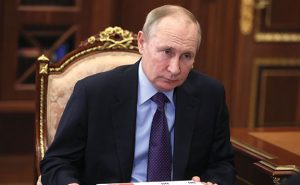War is coming — a not-so-great northern war.
Don’t be fooled by last week’s conversation between Russian President Vladimir Putin and his American counterpart Joe Biden, with its promise of further negotiations in January. When one party is bent on war, this kind of diplomatic activity often continues until just hours before hostilities begin. We should not be deluded: Putin is bent on war against Ukraine.
On December 17, Russia issued a virtual ultimatum to the US and the North Atlantic Treaty Organisation (Nato) — the keystone of European security since its founding in 1949 — by publishing two draft security agreements, one a bilateral US-Russia treaty and other a multilateral Nato-Russia agreement.
An agreement not to deploy Nato forces to former Warsaw Pact member states would reinstate the 25-year-old Founding Act, which Nato partially froze after Russia annexed Crimea in 2014. Nato still does not permanently station troops in Eastern Europe because it never formally abrogated the Founding Act. Russia’s proposed limits on military exercises similarly recall the Conventional Armed Forces in Europe Treaty, which Moscow suspended in 2007.
The Russian demands also include several obvious non-starters. Nato is highly unlikely to revoke its promise, made in 2008, of eventual membership for Ukraine and Georgia. Even if Biden wanted to accede to Russia’s demand that the US end military cooperation with Ukraine, Congress would almost certainly not let him, and could legislate military aid on its own. Finally, Russia’s demand that the US not station nuclear weapons abroad would overturn a founding principle of Nato — nuclear sharing between member states.
Taken together, the Russian demands imply nothing less than a “new Yalta†that would effectively concede to Russia a sphere of influence extending across the former Soviet republics in Eastern Europe, much like the original Yalta Agreement of 1945, as well as eroding the security of former Warsaw Pact countries. Such demands would be worth discussing only if Russia offered something major in return — for example, a withdrawal of all its forces from Ukrainian territory. But Putin has no
intention of making concessions. He is preparing a casus belli.
On December 23, Putin held his usual marathon year-end press conference. He explained that even if Russia’s “red line†security guarantees were met on paper, Russia still could not trust the US assurances because he had been “lied to, blatantly†over Nato expansion. For the US to have offensive strike weapons on “Russia’s doorstep,†he said, was like Russia having such weapons in Canada or Mexico. Asked by a journalist if Russia was angry, he quoted the 19th-century tsarist foreign minister Prince Gorchakov: “Russia is not angry, it is concentrating†— as in “concentrating its forces.â€
Western commentators often make the mistake of thinking that Putin’s goal is to resurrect the Soviet Union, recalling his notorious comment in 2005 that the collapse of the Soviet empire was “the greatest geopolitical catastrophe of the century.†To judge by the ruthless way his government has gone after Memorial, Putin does indeed owe some residual fealty to the baleful shade of Stalin.
To understand what exactly Putin meant by this, you need to travel back three centuries, to the time of the Great Northern War (1700–1721). The dominant military power of northern Europe in those days was not Russia but Sweden, then under the leadership of that most extraordinary of Scandinavian warriors, Charles XII. The Great Northern War pitted Charles against Frederick IV, the king of Denmark and Norway; Augustus the Strong, who was simultaneously elector of Saxony, king of Poland and grand duke of Lithuania; and the Muscovite tsar, Peter I. By 1709, the Swede had defeated both Frederick and Augustus. But he met his match in Tsar Peter.
At the Battle of Poltava (July 8, 1709), Peter the Great won the most important victory of his reign.
Because of the Russian scorched-earth tactics, the Swedish army had been forced to abandon its advance on Moscow and instead marched south to establish winter quarters. The location Charles XII picked, the town of Poltava, is around 200 miles east of Kyiv. Today it lies in eastern Ukraine, not far from the contested areas around Luhansk and Donetsk, which are controlled by Russian-backed separatists.
Let the Russian troops know that the hour has come which has placed the fate of all the fatherland in their hands, to decide whether Russia will be lost or will be reborn and
improve its situation.
This is the history that inspires today’s Tsar Vladimir, much more than the dark chapters of Stalin’s reign of terror, which will forever be associated in Ukrainian minds with the Holodomor, the genocidal man-made famine inflicted on Ukraine in the name of agricultural collectivisation. It is a history that reminds us how crucial victory in the territory that is now Ukraine was for the rise of Russia as a European great power. It also reminds us that this territory was as contested in the early 18th century as it is today.
In any case, Putin does not need to go to war in the style of 1939, with columns of tanks rumbling across the Ukrainian fields. A full-scale land invasion is just one of his options. He could also launch an amphibious assault on Ukraine’s Black Sea coast, or a precision bombing and missile campaign against key Ukrainian targets. He could seize additional territory in Ukraine’s eastern region by ramping up the weaponry of its
militias in the region. Or he could launch large-scale cyberattacks, crippling Ukrainian communications and infrastructure.
If Putin does take military action, it is therefore pretty clear that Ukraine will receive no significant military support from the West. Indeed, on December 8 Biden explicitly ruled out sending US troops, and the White House has delayed the delivery of military aid to Kyiv for fear of provoking Putin.
—Bloomberg
Niall Ferguson is the Milbank Family Senior Fellow at the Hoover Institution at Stanford University and a Bloomberg Opinion columnist
 The Gulf Time Newspaper One of the finest business newspapers in the UAE brought to you by our professional writers and editors.
The Gulf Time Newspaper One of the finest business newspapers in the UAE brought to you by our professional writers and editors.

